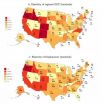(Press-News.org) CAMBRIDGE, MA -- Sequencing the genomes of tumor cells has revealed thousands of mutations associated with cancer. One way to discover the role of these mutations is to breed a strain of mice that carry the genetic flaw — but breeding such mice is an expensive, time-consuming process.
Now, MIT researchers have found an alternative: They have shown that a gene-editing system called CRISPR can introduce cancer-causing mutations into the livers of adult mice, enabling scientists to screen these mutations much more quickly.
In a study appearing in the August 6th issue of Nature, the researchers generated liver tumors in adult mice by disrupting the tumor suppressor genes p53 and pten. They are now working on ways to deliver the necessary CRISPR components to other organs, allowing them to investigate mutations found in other types of cancer.
"The sequencing of human tumors has revealed hundreds of oncogenes and tumor suppressor genes in different combinations. The flexibility of this technology, as delivery gets better in the future, will give you a way to pretty rapidly test those combinations," says Phillip Sharp, the David H. Koch Institute Professor at MIT and an author of the paper.
Tyler Jacks, director of MIT's Koch Institute for Integrative Cancer Research and the David H. Koch Professor of Biology, is the paper's senior author. The lead authors are Koch Institute postdocs Wen Xue, Sidi Chen, and Hao Yin.
Gene disruption
CRISPR relies on cellular machinery that bacteria use to defend themselves from viral infection. Researchers have copied this bacterial system to create gene-editing complexes that include a DNA-cutting enzyme called Cas9 bound to a short RNA guide strand that is programmed to bind to a specific genome sequence, telling Cas9 where to make its cut.
In some cases, the researchers simply snip out part of a gene to disrupt its function; in others, they also introduce a DNA template strand that encodes a new sequence to replace the deleted DNA.
To investigate the potential usefulness of CRISPR for creating mouse models of cancer, the researchers first used it to knock out p53 and pten, which protect cells from becoming cancerous by regulating cell growth. Previous studies have shown that genetically engineered mice with mutations in both of those genes will develop cancer within a few months.
Studies of such genetically engineered mice have yielded many important discoveries, but the process, which requires introducing mutations into embryonic stem cells, can take more than a year and costs hundreds of thousands of dollars. "It's a very long process, and the more genes you're working with, the longer and more complicated it becomes," Jacks says.
Using Cas enzymes targeted to cut snippets of p53 and pten, the researchers were able to disrupt those two genes in about 3 percent of liver cells, enough to produce liver tumors within three months.
Many models possible
The researchers also used CRISPR to create a mouse model with an oncogene called beta catenin, which makes cells more likely to become cancerous if additional mutations occur later on. To create this model, the researchers had to cut out the normal version of the gene and replace it with an overactive form, which was successful in about 0.5 percent of hepatocytes (the cells that make up most of the liver).
The ability to not only delete genes, but also to replace them with altered versions "really opens up all sorts of new possibilities when you think about the kinds of genes that you would want to mutate in the future," Jacks says. "Both loss of function and gain of function are possible."
Using CRISPR to generate tumors should allow scientists to more rapidly study how different genetic mutations interact to produce cancers, as well as the effects of potential drugs on tumors with a specific genetic profile.
In this study, the researchers delivered the genes necessary for CRISPR through injections into veins in the tails of the mice. While this is an effective way to get genetic material to the liver, it would not work for other organs of interest. However, nanoparticles and other delivery methods now being developed for DNA and RNA could prove more effective in targeting other organs, Sharp says.
INFORMATION:
The research was funded by the National Institutes of Health and the National Cancer Institute.
A new way to model cancer
2014-08-06
ELSE PRESS RELEASES FROM THIS DATE:
Discovery yields master regulator of toxin production in staph infections
2014-08-06
St. Jude Children's Research Hospital scientists have discovered an enzyme that regulates production of the toxins that contribute to potentially life-threatening Staphylococcus aureus infections. The study recently appeared in the scientific journal the Proceedings of the National Academy of Sciences (PNAS).
Researchers also showed that the same enzyme allows Staphylococcus aureus to use fatty acids acquired from the infected individual to make the membrane that bacteria need to grow and flourish. The results provide a promising focus for efforts to develop a much-needed ...
Pyrocumulonibus cloud rises up from Canadian wildfires
2014-08-06
The Northern Territories in Canada is experiencing one of its worst fire seasons in history. As of this date, there have been 344 wildfires that have burned 2,830,907 hectares of land (close to 7 million acres). The area around the Great Slave Lake, Yellowknife, Ft. Smith, and the Buffalo Lake have been plagued with uncontrolled fires all season long. This natural-color image collected by the Moderate Resolution Imaging Spectroradiometer (MODIS) aboard the Aqua satellite on August 05, 2014 shows a pyrocumulonimbus cloud erupting from the fire north of Buffalo Lake. It ...
A website to help safeguard the United States borders against alien scale insect pests
2014-08-06
Scales are small insects that feed by sucking plant juices. They can attack nearly any plant and cause serious damage to many agricultural and ornamental plants. While native scales have natural enemies that generally keep their populations in check, invasive species often do not, and for this reason many commercially important scale pests in the United States are species that were accidentally introduced.
In order to facilitate the identification of alien species at U.S. ports-of-entry, scientists of the United States Department of Agriculture and California Department ...
Discovery about wound healing key to understanding cell movement
2014-08-06
Research by a civil engineer from the University of Waterloo is helping shed light on the way wounds heal and may someday have implications for understanding how cancer spreads, as well as why certain birth defects occur.
Professor Wayne Brodland is developing computational models for studying the mechanical interactions between cells. In this project, he worked with a team of international researchers who found that the way wounds knit together is more complex than we thought. The results were published this week in the journal, Nature Physics.
"When people think ...
Geography matters: Model predicts how local 'shocks' influence U.S. economy
2014-08-06
PRINCETON, N.J. -- A sudden closing of a major airline hub such as the main Atlanta airport would undoubtedly leave thousands of travelers stranded. Because of Atlanta's hub status, such a blow would be felt nationally, altering the travel plans of millions while impacting the travel industry, tourism and other segments of the economy.
A team of economists including Esteban Rossi-Hansberg of Princeton University's Woodrow Wilson School of Public and International Affairs have developed a model that can measure the widespread effects of local industry fluctuations such ...
Researchers seek 'safety lock' against tumor growth after stem cell transplantation
2014-08-06
Putnam Valley, NY. (Aug. 6, 2014) – Recent studies have shown that transplanting induced pluripotent stem cell-derived neural stem cells (iPS-NSCs) can promote functional recovery after spinal cord injury in rodents and non-human primates. However, a serious drawback to the transplantation of iPS-NSCs is the potential for tumor growth, or tumorogenesis, post-transplantation.
In an effort to better understand this risk and find ways to prevent it, a team of Japanese researchers has completed a study in which they transplanted a human glioblastoma cell line into the intact ...
New research debunks the family myth as primary reason for gender gap in politics
2014-08-06
Female candidates for elected office do as well as male candidates in terms of raising money and winning votes, so why do women only occupy 19 percent of congressional seats and approximately 25 percent of statewide offices and hold fewer governorships and mayorships? The traditional wisdom has been family obligations and responsibilities prevent women from running for office.
"But in none of the scholarly research where scholars attempt to establish a link between family roles and political ambition did traditional family arrangements prevent women from eventually running ...
Boomers building muscle at the gym -- without passion
2014-08-06
This news release is available in French. Montreal, August 5, 2014 — As the first generation to embrace exercise, baby boomers continue going to the gym, yet more out of necessity than for the challenge and enjoyment of physical activity.
In a study recently published in the International Journal of Wellbeing, James Gavin, a professor in Concordia's Department of Applied Human Sciences, investigates our motivations for exercise, from looking good to having fun. He finds that for the baby boom generation, passion is the most important motivator — a fact the fitness ...
Study shows low uptake of colorectal cancer screening by African Americans in a Veterans Affairs healthcare network
2014-08-06
DOWNERS GROVE, Ill. – August 6, 2014 – According to researchers in California, African Americans' participation in colorectal cancer screening is low and the use of colonoscopy infrequent despite similar access to care across races in a Veterans Affairs healthcare system. The researchers also found that having established primary care at the time of screening eligibility significantly increased screening uptake. The study appears in the August issue of Gastrointestinal Endoscopy, the monthly peer-reviewed scientific journal of the American Society for Gastrointestinal Endoscopy ...
Dementia risk quadrupled in people with mild cognitive impairment
2014-08-06
Amsterdam, NL, August 6, 2014 – In a long-term, large-scale population-based study of individuals aged 55 years or older in the general population researchers found that those diagnosed with mild cognitive impairment (MCI) had a four-fold increased risk of developing dementia or Alzheimer's disease (AD) compared to cognitively healthy individuals. Several risk factors including older age, positive APOE-ɛ4 status, low total cholesterol levels, and stroke, as well as specific MRI findings were associated with an increased risk of developing MCI. The results are published ...



